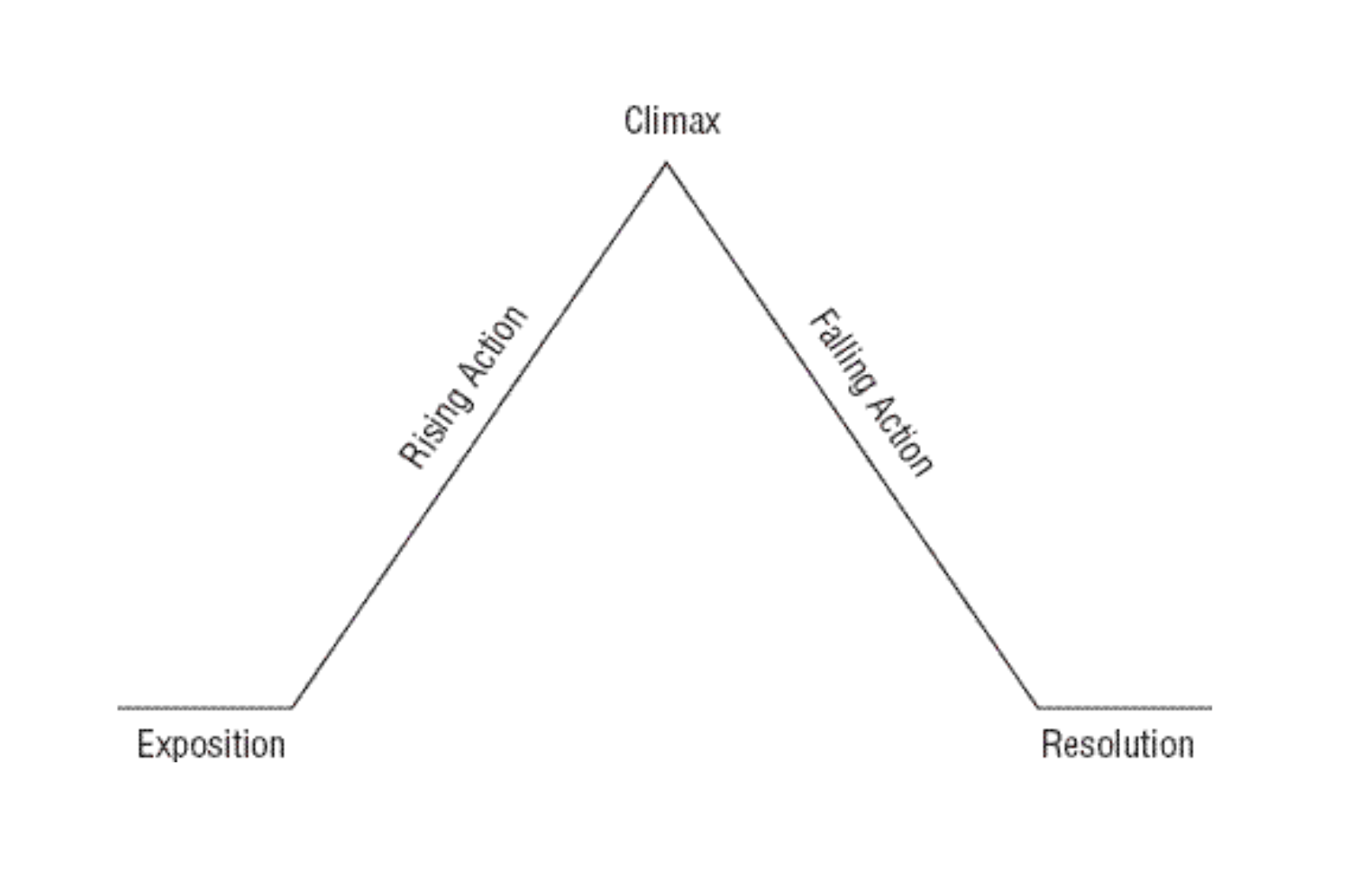The Elements of Plot:
Links in a Chain
Plot is a series of events or scenes within a book, story, film or production that when put together in a meaningful way, create the overarching story and theme.
by Vanessa J. Chandler

About the Author
Vanessa Joy Chandler is a ghostwriter, teacher and publishing consultant of numerous literary works featured in the Washington Post, Fox News, The Eric Metaxas Show and Focus on the Family. She teaches book writing classes online and lives with her husband in a small village in German wine country.
What are Story Elements?
As a ghostwriter and publisher, the most common question I have been asked by clients in the past 17 years is, “Is my book any good?” That is a subjective question, and I often felt as if I held their hearts in my hands—to either fly high or crash far below—through my carefully worded answers.
I do believe that writing requires talent, whether it is earned through rigorous study and application, or it is naturally gifted. Still, in order to answer such a general and ubiquitous question, we must first note that what defines classical literature, or literary fiction, answers the even broader question of, “What makes a story ‘good’?” Some modern authors fall short of great writing simply because they do not seek to read, understand and break down classic literature and the parts of a story, short story, book, play, film or production that when placed together in a meaningful way, make it worthy, or “good.” There is reason to read the old classics and noteworthy modern authors, for as the old saying goes, “Great readers make great writers.”
What is Great Literature?
Literary Fiction is a work of art that follows traditional literary guidelines: It contains essential literary elements and stylistic elements within the structure of its story. Generally speaking, when these elements are placed together strategically, they create a good story. A story missing one or more of these literary features, however small, will be found lacking.
Literary Fiction is a work of art that follows traditional literary guidelines: It contains essential literary elements and stylistic elements within the structure of its story.
So, then, what makes a story “good?” Believe it or not, the elements of fiction, or stylistic features that create literature, was once a philosophical question. The secret lies within the term commonly known as, Plot. Plot was inspired by the Greek philosopher, storyteller and story-architect, Aristotle, over 2,000 years ago. It is a series of events or scenes within a book, story, film or production that when put together in a meaningful way, create the overarching story and theme. Each stylistic element of Plot works together like a chain-link fence, meaning that only when the elements of plot are complete and sown together in a significant and meaningful way does the greatest story arise.
It is perhaps best illustrated by the following shape:

What is Plot?
A brief overview of Plot and the parts of a story as illustrated above are as follows:
Exposition—An “Inciting Incident” or “Hook,” in addition to any necessary background information, facts or insights the Reader needs to know in order to be drawn into the story.
Rising Action—A series of “Events” or “Scenes” in the story like links in a chain that create tension caused by the main character’s internal and/or external conflict, which ultimately build into a climax.
Internal/External Conflict—The posed question or problem that must be solved by the main character throughout the course of the story.
Climax—The highest point of emotional intensity or suspense within the story (that feeling of, “I can’t put this book down right now!”).
Falling Action—A series of events after the Climax that have a calming effect on Reader. These events tie up “loose ends” that might have been exposed prior to the climax.
Resolution—The ending of the story that effectively gives “resolution” to all events in the story and “resolves” the conflict(s) that was introduced at the beginning.
What is Story Structure?
All good stories begin with an Exposition that provides Setting, the necessary background information, sufficient knowledge and any noteworthy facts the Reader needs to know in order to “jump in” to the story, so to speak. One of the most effective ways to draw a Reader in to the Exposition is through an Inciting incident or Hook, something exciting or significant that happens that “incites” the action of the story and causes the Reader to be “hooked” so that he/she would like to keep reading.
An author must provide the perfect balance between giving enough information about the Basic Situation of the book, so that the Reader has enough background information to understand Who?, What?, When?, Where? and Why?, yet not so much to keep the Reader hanging on to the story, wanting to find out more. The Exposition should also foreshadow or create suspense surrounding the main character’s journey. If the Reader is not hooked within the first page of the book, it is likely that he/she will put down the book and find something else to do.
To use an example from the famous teen series, The Hunger Games by Suzanne Collins, the main character, Katniss, wakes up on the day of the reaping, the day that falls once per year wherein two young people from her district will be picked to compete in the Hunger Games. No one knows who these two people—one boy and one girl—will be. It could be Katniss. I could be her best friend Gale, or even her little sister Primrose. This is an exciting starting point that foreshadows the doom that lies before the main characters and leaves the Reader wanting to know more; thus, it is an event that “incites” a sufficient reaction from the Reader, lending it the name of Inciting Incident.
The Hard Road: What if Almost Dying is the Very Thing that Saved Your Life? by Michael Pruett, and a business biography, Prosperity with Purpose: An Executive’s Search for Significance by Fortune 500 Executive Mike Frank.

Elements of Fiction
Once the background information has been introduced, the Internal (emotional, psychological or philosophical) and/or External Conflict (facing an enemy or adversary, world crisis or natural disaster) arises, sometimes coinciding with the Hook. This Conflict poses a question or problem that the main character(s) must solve throughout the course of the story.
Utilizing the illustration above, Katniss’ conflict is first internal: "Can she handle the unknown of the Reaping Day?” “Does she have the strength to volunteer in place of Prim when Prim is chosen?” Thereafter, it is external: winning the Hunger Games so that she can get back to her family and Gale.
Within Aristotle’s original definition of Plot found in his book Poetics, Hubris, the Greek word for pride, or the belief that one is superior to another, is an illustration of a character’s main internal conflict. In this case, the character’s motivation is tested, meaning: “Will the character overcome the conflict, or fail by the end of the story?”
One of the first recorded illustrations of Hubris as an internal conflict was in Sophocles’ play, “Oedipus Tyrannus.” Out of Hubris, the main character Oedipus attempts to escape the tragic fate that has been prophesied over his life, but the truth is that he actually enabled his fate by trying to avoid it. He did not overcome his internal conflict and the audience was left with the weight of the tragedy. While the original Greek tragedies ended in just that—tragedy—most Readers today want to experience a story emotionally, and be fulfilled by it, which means that they want a hero, a good guy to win, or the character to experience a victory over conflict, whether internal or external. How a Reader feels (intrigued, excited and fascinated, or frustrated, overwhelmed, defeated) while reading your book determines whether or not he/she will keep reading.
As a story progresses, the events/scenes become cause-and-effect driven, meaning that they are linked together like a chain-linked fence: One event leads to the next event, which leads to the next even, and so on and so forth. The goal is for the momentum, emotional energy and intensity of the events to continuously rise, which is called the Rising Action.

Each and every event or scene in a book must be crucial to not only the telling of the story, but also pushing the action forward. If it isn’t, it should be thrown out. The Rising Action eventually reaches a point of explosion or eruption, like a volcano; this is called the Climax. The Climax is the most emotionally heightened part of the story, meaning that it should keep the Reader on the edge of his/her seat, wondering what will happen next.
Going back to the Hunger Games, the Climax takes place when Katniss and Peeta fight Cato on top of the Cornucopia. After they throw Cato below and he is torn apart by the creatures below, there is a false sense of security because the Reader believes both Katniss and Peeta can win the game together. However, the Game Maker announces that once again, there can only be one winner. The Reader is, essentially, emotionally stressed in a good way, wondering how the main characters could possibly solve this final conflict. Thus, the Climax—the emotional intensity—is prolonged, leading to a greater emotional satisfaction for the Reader in the Falling Action and Resolution. Katniss defies all thought and President Snow by presenting Nightlock berries that will kill them both instead of one of them killing the other. The Game Maker and President Snow know that if this were to happen, more districts would be incentivized to rebel. So, the games are stopped immediately and both Katniss and Peeta are allowed to survive.
This leads us into the Falling Action, a series of scenes or events after the Climax that have a calming effect on Reader. These events tie up “loose ends” that might have been exposed prior to the climax. It is a winding down of the story, so to speak, that shakes off the effects of the Climax, calming the Reader and ending the circle of story and thought that the Reader has been engaged in during the course of the book.
Finally, we arrive at the Resolution, the ending of the story that effectively gives “resolution” to all events in the story and “resolves” the Conflict(s) that was introduced at the beginning. This should, again, be emotionally satisfying for the Reader, which typically means that the main character has won the Conflict and either goes back to normal life, or his/her life or relationships are expanded in a noteworthy way.
How to Write a Book
In order to grab a Reader’s attention, a non-fiction book must also contain extraordinary literary elements. I teach my students that the writing terms which define literary fiction are also true for how to write non-fiction prose, or how to write a book in general. We have enough teaching books that simply tell the Reader about the author’s experience, but don’t provide the Reader an avenue to experience or feel anything new. Even within a non-fiction book, a Reader wants to be transported into a new world, living a thousand lives in one, experiencing profound feelings and being intellectually stimulated.
How to Write Creatively
The Master Storyteller, Robert McKee, states in his book Story: Style, Structure, Substance, and the Principles of Screenwriting, “Story isn’t a flight from reality but a vehicle that carries us on our search for reality, our best effort to make sense out of the anarchy of existence.
Think of things that all humans experience, like love and death. If a story has one of these two themes, everyone who reads it will be able to relate to it. That is, in effect, the goal. This is called a universal experience—the common bond between all humans. In fact, these stories we tell of hope, love, triumph or heartache, tragedy and pain are the human experience. They are, in effect, what make us human. Take a universal experience from your own life and express it in such a way utilizing literary technique that you create a world in which the Reader may also see it through your eyes and experience it with you.
If you can create text that moves the Reader, whether this be sublime satisfaction, or frustrating disturbance, you have won the game of how to write well.
Vanessa’s Resources
Download Vanessa’s Plot Worksheet here to assist in creating the Parts of Plot for your own book.
Download Vanessa’s Cause-and-Effect Worksheet here to assist in creating the Rising Action for your own book.
Affiliate Book Resources
- Robert McKee, Story: Style, Structure, Substance, and the Principles of Screenwriting
Dwight V. Swain, Techniques of the Selling Writer
Julia Cameron, The Artist's Way
Steven Pressfield, The War of Art






